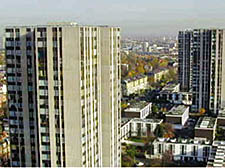|
|
 |
| |

Dorney flats in Camden’s Chalcot estate

Chris Holmes

Austin Mitchell MP |
Good housing for all: Where did we go so wrong?
Britain's housing policy over the last 20 years has been a disaster, writes Austin Mitchell
A New Vision for Housing by Chris Holmes
Routledge, £2.20
OVER the last three decades Britain’s housing policy has
been a unique national disaster. Good housing is crucial to
the good life but of all the great fields of welfare: health,
education social security, housing has been the worst handled,
the worst financed and the least effective, a process which
has led to the present housing disaster.
Chris Holmes’s informative little book provides not
only the best description and analysis of the failures but also
a potential, though not in my view, entirely practicable way
out. Everyone with an interest in housing should read it.
What went wrong? In the immediate post-war period the housing
record was good. Record building levels, particularly in the
1950s, good Labour records in council house building and housing
as a major dynamic of the economy. Then in the 1960s it began
to go wrong. In came the Poulson inspired tower blocks (my index
of how corrupt northern councils were then is the number of
tower blocks divided by the population) and the concrete estates
the architects wouldn’t live in. Both rapidly turned from
show places to dumping grounds. After the 1976 IMF crisis investment
in public housing turned to disinvestment and in the 1980s under
the Tories came the great sale of council housing at give-away
prices.
This picked the eyes out of the estates, sold off the best housing
and ended transfers and flexibility.
New council builds to replace the sales should have been the
accompaniment but building stopped totally. Then mass unemployment
which made the estates and the housing associations ghettoes
of the poor who were forced to pay the housing benefit of the
poorest.
Finally Labour came back to power. We expected and hoped that
it would try to solve the problem.
It did, indeed, begin to invest again in social housing but
built no new council housing and mainly concentrated on being
tougher in enforcing the Tory policy of bullying, bamboozling
and bribing councils into privatising their council housing
at a record rate.
All these messy processes are described by Holmes, and their
consequences are tied down geographically by more detailed studies
of the situation in Liverpool and London. Which makes his book
an excellent guide to the disaster even though it’s a bit
passionless.
The outcome is that new social build (all of it by housing associations
for councils who have not been allowed to build for 30 years)
fell to low levels unparalleled since 1924.
Build to own was also at record lows leading to rocketting house
prices which have ensured that a higher and higher proportion
of the population needs public housing to rent because they
can’t raise enough to put down the deposit to buy. Which
is the nub of the problem and the cause of our present tragedy.
We desperately need over 100,000 houses a year, particularly
in the south east, to match rising demand, cope with the multiplication
of households as we divorce and separate, and face increased
immigration.
We aren’t building enough. So we get rocketting prices,
rising waiting lists and homelessness, people living in crowded
conditions or with in-laws. Investment which should be going
into house building as well as industry and production is now
pouring into asset appreciation in property. This happens in
no other European country. There house prices haven`t been galloping
in the same way because they`re actually built according to
need. It is, in short, a national disgrace. To our shame it`s
largely been produced by Labour.
Holmes wants more variety of build and tenure to give people
a wider choice, diversity of strategies, ownership and rentals,
and an emergency homeless programme based on buying up older
housing. He envisages an expansion of building by 60,000 rented
houses and 30,000 for low cost ownership, all financed by £3.5
billion extra public spending.
All quite right, though his programme for dealing with the other
glaring anomaly of huge capital gains made by home owners while
renters get nothing, beyond the forthcoming rent increases,
is more naive because it requires taxing capital gains on housing
and creating housing bonds to give renters a stake in ownership.
Neither is likely.
My own proposal is simpler. Develop the Thames Gateway and other
areas north of London on the new town principle which was so
successful after the war. Raise the money from the private sector
by massive PFI programmes. Stop draining private investment
into existing housing by allowing councils to keep their own
houses and money, particularly the £1.5 billion taken
from Housing Revenue Accounts every year to pay historic debt
and the half billion from Right to Buy sales. Then protect tenants,
not by giving them a stake in their property, but a permanent
guarantee of lower rents which will allow them to raise the
money to buy later making social housing a place for transition
not a permanent pool of poverty.
None of this is easy but things have got too bad for any easy
answers. What we need is a serious effort to do something. That
will include extra taxation and political leadership both presently
lacking.
As Holmes puts it: “What is not acceptable is to do nothing.
Current policies will not achieve satisfactory housing for all
members of the community, especially those who are severely
overcrowded or in temporary accommodation because they are homeless.”
At the end of the day, Holmes, myself and Defend Council Housing
are making a common plea. Stop fighting the councils. Enlist
them in a huge programme of building and regeneration. Britain
needs it. The economy will be boosted by it. Labour must get
on with it.
|
|
 |
|



